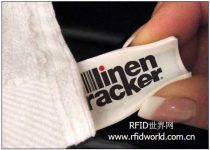
RFID Linentracker automatically manages hotel linens
[ad_1]
Some hotels use RFID technology to track uniforms, provide keyless entry or simplify the registration process. Now, the new company Linentracker provides an RFID system to track the inventory of towels and sheets in the hotel, while also improving the efficiency of cleaning and adding these items.
The company started its first pilot project with a hotel in California at the beginning of this year. The project was originally planned for 6 months, according to William Serbin, CEO of Linentracker, but due to the good results of the project, the hotel decided to extend it without restrictions.
Linentracker’s solution uses passive, UHF tags and readers that comply with the EPC Gen 2 (ISO 18000-6c) standard. This system allows the hotel to obtain the quantity of linen products in the hotel in real time, and optimize the process of cleaning and ordering linens.

LinenTracker RFID tag with Alien Technology’s EPC Gen 2 inlay
In the pilot hotel (Serbin declined to name), Alien RFID readers were installed in a linen closet in each guest room (10 floors in total). Readers are also installed at various points in the hotel cleaning room. 20,000 pieces of linen, from towels, sheets to blankets, are all attached with an RFID tag. The label, also provided by Alien Technology, is encapsulated in a waterproof and flexible material to protect the inlay from the high temperature and vibration experienced by the linen product during cleaning. Labels are sewn into the seams of each linen.
According to Serbin, most hotels manually check their linen inventory, and the use of RFID systems can greatly reduce labor costs and improve inventory accuracy.
When cleaners clean the room, Serbin says they usually put dirty linens into a chute that leads to the washing room. Dirty linens were washed the same day. In the evening, a staff member checks the inventory of each closet, and then puts the towels and sheets that are allocated to each floor and will be used tomorrow in a cart.
With the Linentracker system, the cleaning workers in the cleaning room can remotely monitor the inventory of each linen closet by viewing the inventory level displayed on the computer screen. Each label has an ID code to identify the type of linen product. The reader installed in each closet collects the ID code of the tag, the RFID middleware provided by KeyTone Technologies filters the redundant reading, and sends the data to a software developed by Linentracker. Hotel employees use the software to check the quantity of each type of linen in the closet in real time.
Combining the inventory quantity to track the dirty linen products in the washing room, the Linentracker software generates instructions to inform the cleaning workers how many dirty linen products they need to clean to supplement tomorrow’s demand. This means that cleaning workers can optimize their cleaning cycle and avoid unnecessary cleaning, thereby reducing energy and water resources.
Using the real-time inventory data of the closet, the staff stores the required amount of linen for the next day in the cart, eliminating the need to manually check the closet. According to Serbin, the hotel considers this to be one of the biggest advantages provided by the Linentracker system-it not only saves time but also ensures the accuracy of the inventory.
According to Serbin, RFID tags can withstand at least 150 washes and spin-drying, which exceeds the industry average of 100 washes (new products will need to be replaced later), he said.
The Linentracker software records the life cycle of each item, tracks the number of times of washing and drying, and employees decide which products need to be discarded. In this way, the hotel can know which supplier has the highest quality and longest service life.
“Our mission is to assist hotels in effectively tracking their movable assets to improve the guest experience,” Serbin said. “The existing manual process is very time-consuming, and the RFID system can help hotels understand the location of items in real time.”
Another application is to prevent employees from stealing. In the pilot hotel, employees installed a reader at the entrance and exit. In this way, the system can detect whether employees are carrying tagged items in and out.
[ad_2]




